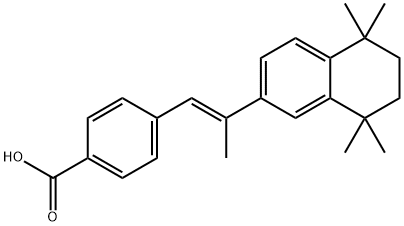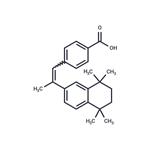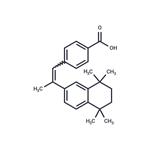Description
TTNPB (Arotinoid Acid) is a potent RAR agonist, and inhibits binding of [3H]tRA with IC50 of 5.1 nM, 4.5 nM, and 9.3 nM for human RARα, β, and γ, respectively.
Uses
- TTNPB is an analog of retinoic acid that potently and selectively activates retinoic acid receptors (RAR; EC50 = 21, 4, and 2.4 nM for RARα, RARβ, and RARγ, respectively; Beard et al.; Wong et al.).
- TTNPB has been used for transcriptional assays in 293T cells. It has also been used as a RAR-agonist in cultured human cord blood CD34+CD38-lin- cells.
- It does not act on retinoid X receptors and weakly agonizes farnesoid X receptor (EC50 > 1 µM).
- TTNPB is used to study RAR action in diverse processes, including epidermal cell proliferation, embryogenesis, and stem cell differentiation.
Biochemical Actions
Selective and highly potent retinoic acid analog with affinity for retinoic acid receptors (RAR) α, β, and γ, which are nuclear transcription factors. Produces ligand-activated transcription of genes that possess retinoic acid responsive elements.
In vitro
TTNPB binds to nuclear retinoic acid receptors with high affinity, inhibits binding of [3H]tRA with IC50 of 3.8 nM, 4.0 nM, and 4.5 nM for mRARα, β, and γ, respectively. TTNPB increases transcriptional activation of Mouse RARs in JEG-3 cells after 72 h using conditioned media with EC50 of 2.0 nM, 1.1 nM and 0.8 nM for mRARα, β, and γ, respectively. TTNPB inhibits the growth of normal human mammary epithelial cells (HMECs) and estrogen receptor-positive (ER-positive) breast cancer cells by inducing G1 cell cycle blockade. TTNPB causes a concentration-dependent decrease in ES-D3 cell differentiation.
In vivo
TTNPB (0.25 mg/kg) causes growth inhibition in both MXT-HS and MXT-HI models by inducing cell apoptosis.
DIFFERENTIATION
- In combination with CHIR99021 or Activin A, induces intermediate mesoderm formation from human or mouse pluripotent stem cells, respectively (Araoka et al.; Oeda et al.).
- Promotes neuronal differentiation in cultured chick caudal neural plate explants (Diez del Corral et al.).
REPROGRAMMING
Enables chemical reprogramming (without genetic factors) of mouse embryonic fibroblasts to induced pluripotent stem (iPS) cells, in combination with CHIR99021, Tranylcypromine, Valproic Acid, 3-Deazaneplanocin A, and E-616452 (Hou et al.).
CANCER RESEARCH
Induces the in vitro growth and differentiation to granulocytes of myeloid progenitors isolated from myelodysplastic syndrome (MDS) patients (Fabian et al.).
Uses
TTNPB is an analog of retinoic acid that potently and selectively activates retinoic acid receptors.
Definition
ChEBI: A retinoid that consists of benzoic acid substituted at position 4 by a 2-(5,5,8,8-tetramethyl-5,6,7,8-tetrahydronaphthalen-2-yl)prop-1-en-1-yl group. It is a synthetic retinoid that acts as a selective agonist for the retinoic acid receptors (RAR).
Biological Activity
Extremely potent analog of retinoic acid, selective for the retinoic acid receptor (RAR) subtype.
Biochem/physiol Actions
Selective and highly potent retinoic acid analog with affinity for retinoic acid receptors (RAR) α, β, and γ, which are nuclear transcription factors. Produces ligand-activated transcription of genes that possess retinoic acid responsive elements.
Safety Profile
An experimental teratogen. Otherexperimental reproductive effects. When heated todecomposition it emits acrid smoke and irritating fumes.
storage
Desiccate at -20°C
References
[1] pignatello m a, kauffman f c, levin a a. multiple factors contribute to the toxicity of the aromatic retinoid, ttnpb (ro 13-7410): binding affinities and disposition. toxicology and applied pharmacology, 1997, 142(2): 319-327.





